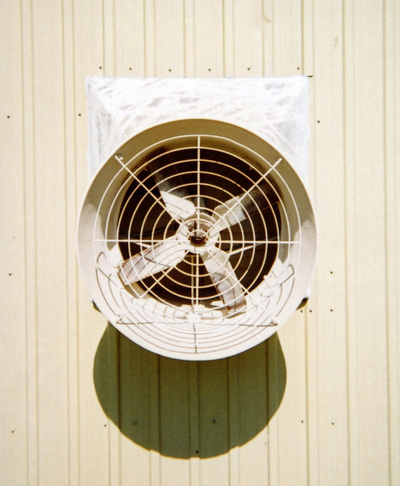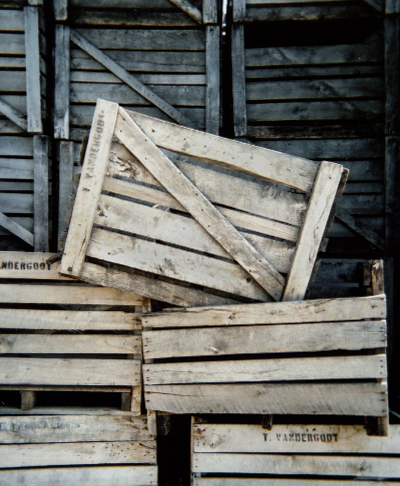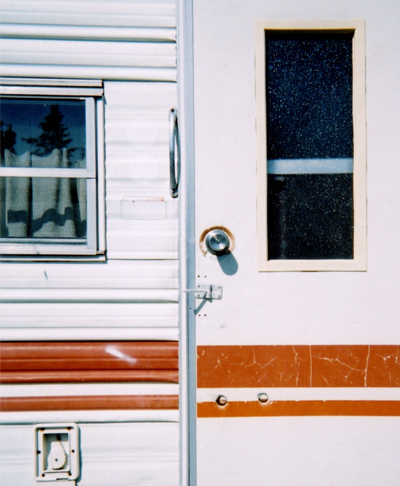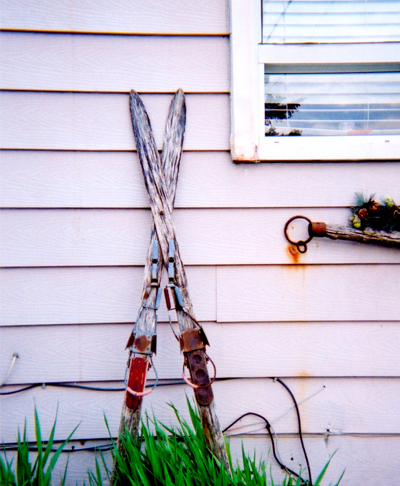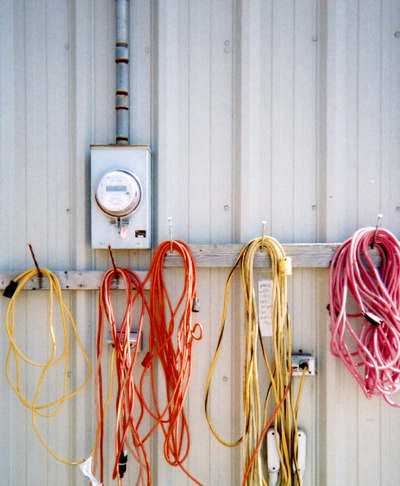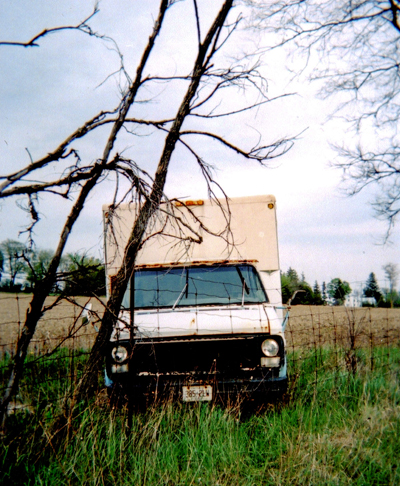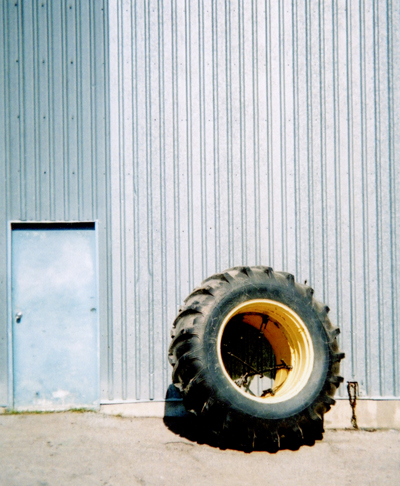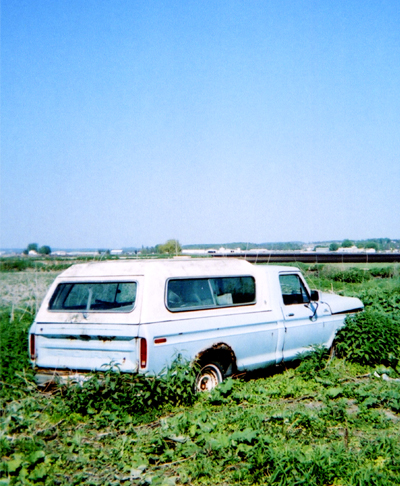⁄At His Disposable
Photographer Zack Vitiello is obsessed with society’s discards.
“I like shitty things,” says the sandy-haired young man, seated at a table tucked at the back of the loud, cramped quarters of 416 Snack Bar. He guzzles back his latest drink of the evening, adding, “And you can quote me on that.”
To the handsome person sitting next to me, shitty things are what he would consider photographable. The shittier the subject, the more photogenic it will be. Hydro meters and neon signs, discarded Christmas trees and trailer homes are the types of soft focus images that make up the online portfolio of up-and-coming Toronto photographer Zack Vitiello.
A recovering concert photographer who gave up shooting bands like Kings of Leon, Fucked Up, Cat Power and the entire Arts & Crafts roster because of the creative control that live shows fail to lend to photographers, Vitiello now finds himself varying his aesthetic depending on his current obsession.
“Disposable cameras lend themselves to taking pictures of things that are really ugly. [They] have this quality. They make everything look like it was taken in a crack den in the ’90s,” he explains of his recent foray into point-and-shoot photography on plastic disposables.
Vitiello doesn’t wax poetic about his style or art. Direct and to the point, his philosophy is that he has no style at all: explore every style that engages you until it no longer does, he says. By showcasing his work on several blogs and websites, each showing a different side of Vitiello and his range of capabilities, it is not only obvious that Vitiello doesn’t strictly prescribe to one style but also that he’s a man of his word. “I’ve always been told you should have one style and be really good at one thing. What’s that famous saying? Jack of all trades, master of none? I don’t want to be considered a jack of all trades.”
Instead, Vitiello comes across as a master of all trades with four websites that span the different stages—and styles—of his life:
his portfolio of concert photography, high-gloss portraits taken during his travels to India, his advertising and design portfolio and The Top Down, his current blog of snapshot photography taken in and around Toronto.
He explains that his short attention span requires him to keep his different styles separate. “By the time I start getting good at something, I lose interest and move on to something else. I put everything in different spaces so that people can choose what they want engage with, rather than just bombarding them with everything I’ve ever done.”
Full of neon signage and grainy point-and-shoot images, The Top Down best emulates his belief that to really learn photography, you don’t need the best tools—you need the right one.
“If anyone ever asked me ‘How do I learn photography?,’ I’d say, ‘Buy a disposable camera.’ There’s no technical know-how involved. You and I should realistically be able to take the exact same picture. What it comes down to is how you frame it and what your catches your eye.”
The growing trend of point-and-shoot photography on disposable cameras is a nod to the ‘90s, an era invoked by Vitiello’s current work. Call it nostalgia or a shift in perspective but Vitiello calls it a forced way of learning through experimentation.
“Using a disposable camera forces you to look at things in a different way. You can’t make the subject matter look beautiful with fancy camera tricks, you have to find subject matter that is inherently interesting. You have to open your eyes a bit wider.”
Learning by doing is exactly how he operates. When he was writing for the online indie music mag CHARTattack in 2008, his editor needed a photographer to shoot a small show during NXNE. Having only used a camera a few times prior, Zack volunteered under the pretense that the photos wouldn’t be used if they were shitty. They weren’t and the rest is history.
Having always been a creative individual, Vitiello has a passion to create, which has led him to his work in advertising.
There’s a fine distinction, he believes, between being creative and being artistic. “Being artistic you don’t need a motive, you just do it. That’s just how you were born. I know artistic people and they will go into a room and paint or draw or take photos and they don’t do anything with it, they’re just expressing themselves. I need four websites. I need a creative job, a place where I get something out of it. With creative work, your work is seen.”
Acting as an art director at a boutique advertising agency, Vitiello has the unique opportunity to combine his passion for photography, film, writing and design into one. Having found his niche in the advertising world, he is expanding his portfolio beyond photography into print ads and package design. He recently directed the Joe Boxer re-brand, for which he brought on old skateboarding friend and The Coveteur photographer Jake Rosenberg to shoot.
His career has come a long way from shooting small-time indie bands to heading up a national campaign overhaul and it’s all because,
like Joe Boxer, Zack Vitiello has balls. He isn’t afraid to be different; he cares to capture the discards many photographers would dismiss.
As he pushes forward, Vitiello is making plans for his next exhibit after a successful show at the Artscape Wychwood Barns, where he sold 17 photos (including three copies of his own National Geographic girl, who he refers to as such because her piercing green eyes invoke comparisons to Steve McCurry’s famous image). This time around, he hopes to showcase a series of photographs that feature walls of peeling paint in Kolkata, where he visited during monsoon season two years ago.
“They don’t strip the paint before they go over the old, shitty paint. So every monsoon season, when the moisture causes it to peel again, it peels off in layers and you get all these beautiful colours and textures,” Zack tells me as we come to the end of our conversation. He waves off commentary that the poor painting choice is nothing more than a poor choice, a band-aid solution.
To Zack Vitiello, that shit is art.
